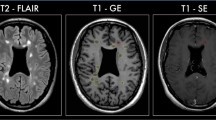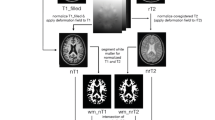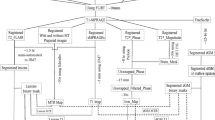Abstract
T1 -hypointense lesions (T1-black holes) in multiple sclerosis (MS) are areas of relatively severe central nervous system (CNS) damage compared with the more non-specific T2-hyperintense lesions, which show greater signal intensity than normal brain on T2-weighted magnetic resonance imaging (MRI). The T1-hypointense lesions are areas of axonal loss, as well as matrix disruption [1, 2]. T1-hypointense lesions are moderately correlated with focal reduction in the magnetization transfer index [3, 4] and reduced N-acetylaspartate (NAA) [2]. T1hypointense lesions appear to evolve from only a subset of prior enhancing MS lesions. Recent studies have suggested that an increase in T1-hypointense lesions is more strongly correlated with progression of disability in secondary progressive MS than T2-hyperintense lesions [5, 6]. For these reasons, the T1 -hypointense lesions are considered to be potential independent markers of the MS disease process compared with the conventional MR measures of subclinical disease — the T2-lesions, and markers of inflammation, the enhancing lesions [7, 8]. Here we summarize the analyses of T1-black holes from the MS Collaborative Research Group Trial of interferon β-1a, which provided an opportunity to determine the natural history of T1-black holes in relatively early MS, in patients with only mild-to-moderate disability, and to evaluate the potential of T1-black holes as a measure of treatment efficacy. Details of this work have been published previously [9].
Access this chapter
Tax calculation will be finalised at checkout
Purchases are for personal use only
Preview
Unable to display preview. Download preview PDF.
Similar content being viewed by others
References
van Walderveen MA, Kamphorst W, Scheltens P et al (1998) Histopathologic correlate of hypointense lesions on T1-weighted spin-echo MRI in multiple sclerosis. Neurology 50:1282–1288
van Walderveen MA, Barkhof F, Pouwels PJW et al (1999) Neuronal damage in T1-hypointense multiple sclerosis lesions demonstrated in vivo using proton magnetic resonance spectroscopy. Ann Neurol 46:79–87
Loevner LA, Grossman RI, McGowan KN, Cohen JA (1995) Characterization of multiple sclerosis plaques with T1-weighted MRI and quantitative magnetization transfer. AJNR 16:1473–1479
van Waesberghe JH, Casteijns JA, Scheltens P, Truyen L, et al (1997) Comparison of four potential MR parameters for severe tissue destruction in multiple sclerosis lesions. Magn Reson Imaging 15:155–162
Truyen L, van Waesberghe JHTM, Barkoff et al (1996) Accumulation of hypointense lesions (“blackholes”) on T1 spin echo MRI correlates with disease progression in multiple sclerosis. Neurology 47:1469–1476
van Walderveen MA, Barkhof F, Hommes OR et al (1995) Correlating MRI and clinical disease activity in multiple sclerosis: relevance of hypointense lesions on shortTR/short TE (T1 weighted) spin echo images. Neurology 45:1684–1690
Miller DH, Albert PS, Barkhof F et al (1996) Guidelines for the use of magnetic resonance techniques in monitoring the treatment of multiple sclerosis. Ann Neurol 39:6–16
Simon JH (1997) Contrast enhanced MR imaging in the evaluation of treatment response and prediction of outcome in multiple sclerosis. J Magn Reson Imaging 7:29–37
Simon JH, Lull J, Jacobs LD et al (2000) A longitudinal study of T1 hypointense lesions in relapsing MS. Results from the MSCRG Trial of interferon beta-1a. Neurology 2000 55:185–192
Jacobs LD, Cookfair DL, Rudick RA et al (1996) Intramuscular interferon beta-1a for disease progression in relapsing multiple sclerosis. Ann Neurol 39:285–294
Simon JH, Jacobs LD, Campion M (1998) Magnetic resonance studies of intramuscular interferon b-1a for relapsing multiple sclerosis. Ann Neurol 43:79–87
Simon JH, Jacobs L, Campion M et al (1999) A longitudinal study of brain atrophy in relapsing MS. Neurology 53:139–148
CHAMPS Study Group (2002) Baseline MRI characteristics of patients at high risk for multiple sclerosis: results from the CHAMPS trial. Multiple Sclerosis 8:330–338
Author information
Consortia
Editor information
Editors and Affiliations
Rights and permissions
Copyright information
© 2004 Springer-Verlag Italia
About this chapter
Cite this chapter
Simon, J.H., Jacobs, L., Simonian, N., The MS Collaborative Research Group. (2004). T1-Hypointense Lesions (T1 Black Holes) in Mild-to-Moderate Disability Relapsing Multiple Sclerosis. In: Hommes, O.R., Comi, G. (eds) Early Indicators Early Treatments Neuroprotection in Multiple Sclerosis. Topics in Neuroscience. Springer, Milano. https://doi.org/10.1007/978-88-470-2117-4_14
Download citation
DOI: https://doi.org/10.1007/978-88-470-2117-4_14
Publisher Name: Springer, Milano
Print ISBN: 978-88-470-2171-6
Online ISBN: 978-88-470-2117-4
eBook Packages: Springer Book Archive




